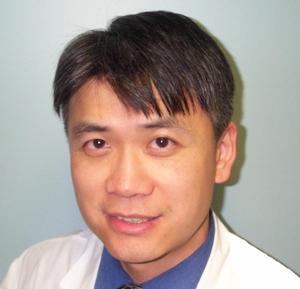Aug 28 2013
A Wayne State University researcher's innovative use of a new tool may make surgery a more viable option for sufferers of obstructive sleep apnea/hypopnea syndrome (OSAHS).
 Ho-Sheng Lin
Ho-Sheng Lin
Ho-Sheng Lin, M.D., a fellow with the American College of Surgeons and professor of otolaryngology-head and neck surgery in the School of Medicine and Karmanos Cancer Institute, reported promising results in the July issue of The Laryngoscope, for treating sleep apnea using transoral robotic surgery (TORS), a technique whose safety and tolerability have recently been established for removing cancerous tumors in the back of the throat.
Patients with OSAHS typically are treated with positive airway pressure (PAP), which is extremely safe and often effective. However, not all OSAHS patients can tolerate PAP, which involves wearing a mask during sleep that forces the airway open so they can continue breathing without interruption.
For patients who cannot tolerate PAP, surgery may be a viable alternative. A common procedure, uvulopalatopharyngoplasty (UPPP), targets the obstruction at the level of the soft palate, but has only been found to be effective in less than 50 percent of cases.
Lin, who also is chief of the otolaryngology section in the surgery department at the John D. Dingell VA Medical Center, said the less-than-optimal result from UPPP is not surprising. In patients with OSAHS, obstruction of air flow can occur at multiple levels of the throat; UPPP only addresses blockage at the soft palate level.
"In order to be maximally effective, the surgeon must evaluate each patient individually to identify the exact site or sites of airway obstruction and then direct the surgical treatments to address those obstructions," Lin said.
Obstruction at the back of the tongue (BOT) can play a significant role in sleep apnea. Traditionally, surgical treatment of BOT blockage has been challenging because it's hard for doctors to see and operate in that region.
Using a robotic device called the da Vinci Surgical System, Lin can now gain improved access to the BOT region to safely and precisely remove the excessive tissue causing airway obstruction. In this study, he reported on the outcome of 12 patients - nine women and three men - who underwent BOT resection via TORS. They were selected for analysis because they underwent removal of excessive BOT tissue and nothing else.
Two prior studies, one from Europe and another from the United States, also looked at treatment outcome following TORS-assisted BOT surgery in sleep apnea patients. However, in those studies, the BOT surgery was done in conjunction with other upper-airway surgeries, making it difficult to assess the effectiveness of the BOT procedure alone. Because all patients in Lin's study underwent only BOT surgery, it is the first to look at the effectiveness of only the TORS-assisted BOT resection.
"Despite undergoing only the BOT procedure, our patients' surgical outcomes appeared similar to those who underwent BOT in addition to other upper-airway surgeries," Lin said.
Significant improvements were seen in the apnea-hypopnea index (AHI) of 75 percent of patients. AHI assesses the severity of sleep apnea based on the total number of complete cessations (apnea) and partial obstructions (hypopnea) of breathing occurring per hour of sleep. Even the other 25 percent saw improvements in their condition, Lin said, with some now better able to tolerate PAP treatments.
Although his study results appear promising, Lin said because of the unique nature of each OSAHS sufferer, as well as his necessarily small sample size, more work is needed with larger groups in order to further assess the efficacy of TORS-assisted BOT, with an eye toward developing standardized criteria as to which patients would benefit from it most.
"The procedure we have focused on is not a cure-all, and its use is still in its infancy," Lin said. "But surgeons now have a new, safe and precise technique to add to their OSAHS treatment options."
Wayne State University is one of the nation's pre-eminent public research institutions in an urban setting. Through its multidisciplinary approach to research and education, and its ongoing collaboration with government, industry and other institutions, the university seeks to enhance economic growth and improve the quality of life in the city of Detroit, state of Michigan and throughout the world. For more information about research at Wayne State University, visit http://www.research.wayne.edu.